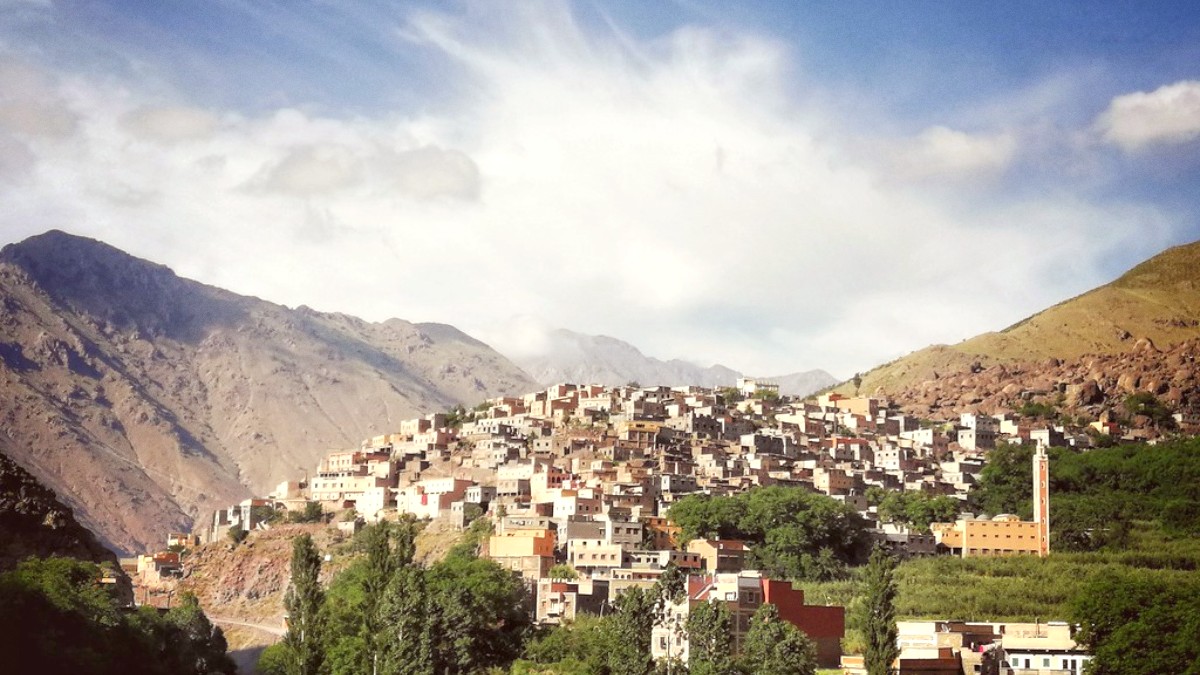
Morocco
Imlil's cuisine is predominantly Berber, rooted in High Atlas Mountain traditions. This cooking style is simple, robust, and uses locally available ingredients from terraced fields or valleys. The historical context of mountain life, with strenuous activity like farming and trekking, means meals focus on sustenance and energy.
Dishes are typically slow-cooked, making flavors meld and ingredients soften, creating comforting and nourishing food. The culinary practices here reflect a deep connection to the land and a reliance on seasonal produce.
In guesthouses, meals are often served communally. Guests gather around a large table, sharing dishes, a wonderful way to interact with other travelers and sometimes the host family.
Always wash your hands thoroughly before and after meals. If eating with your hands (common with bread to scoop food), always use your right hand. Bread (khobz) serves as your main utensil.
Mint tea (Atay bi nana) is a symbol of Moroccan hospitality. Accept it when offered; refusal can cause offense. Pouring tea from a height into small glasses forms part of the ceremonial experience.
The most iconic Moroccan dish, a slow-cooked stew named after the earthenware pot with a conical lid where it is prepared. Long, gentle cooking makes ingredients tender and flavors deep.
Universally available at all guesthouses and local eateries.
Steamed semolina grains typically served with meat (often chicken or lamb) and steamed vegetables, all with a flavorful broth. A staple grain. Widely available at guesthouses for dinner.
Traditionally served on Fridays, but guesthouses often offer it daily.
A rustic, flavorful omelette cooked and served directly in a small tagine pot. Eggs are cooked with finely diced tomatoes, onions, and spices, making a comforting and savory dish.
Common for breakfast or a light lunch at guesthouses.
A thick, nutritious brown dip unique to the Berber region. Made from roasted almonds, argan oil, and honey, Amlou has a rich, nutty, and sweet flavor. Often served with fresh bread for breakfast. It is an energy boost.
Seasonal fruits are common. Moroccan pastries are less common than in cities but sometimes available.
Kasbah du Toubkal has a higher-end dining experience for its guests, with fixed menus of exquisitely prepared Moroccan and Berber dishes, often with fresh, local ingredients and stunning views. This is the most luxurious dining option in Imlil.
Most guesthouses (auberges and riads) offer half-board (breakfast and dinner) with set menus. These guesthouse meals are the main mid-range dining option, giving delicious, home-cooked Moroccan food.
Very few independent restaurants exist in Imlil. Small local shops sell basic groceries, snacks, and drinks. Most budget travelers use the economical and substantial meals from their gîte d'étape.
International cuisine is absent in Imlil. Focus stays exclusively on local Moroccan and Berber dishes, giving an authentic culinary immersion.
Expect only local flavors for an authentic experience.
Street food options are limited in Imlil compared to larger Moroccan cities. Small local shops sell basic snacks, fresh bread, and bottled drinks.
Do not expect the same variety of street food stalls seen in Marrakech.
Less common than in cities, but sometimes available. Often feature nuts, honey, and delicate dough.
Lamb dishes become central to celebrations during this festival.
Harira soup, dates, and sweets are eaten after sunset to break the fast.
Meals feature locally available ingredients harvested from terraced fields or valleys.
This can be hard. Couscous and most bread contain gluten. Tagines are often naturally gluten-free. Communicate clearly with your guesthouse early about your needs. They may prepare rice or other gluten-free alternatives.
Advanced communication is .
Always communicate any severe allergies clearly and in writing if possible. Cross-contamination risk exists in small kitchens. Be ready to manage your allergies actively.
Best to inform guesthouse and guide early.
Formal cooking classes and food tours are not common in Imlil itself. Some guesthouses might arrange informal cooking demonstrations if you ask.
On treks through the valleys, you may pass through villages where locals cultivate terraced fields or keep livestock. This gives an informal glimpse into local food production.
Has a higher-end dining experience for its guests, with fixed menus of exquisitely prepared Moroccan and Berber dishes.
Most guesthouses offer half-board with set menus. These meals are the main mid-range dining option.
Small local shops sell basic groceries and snacks. Most budget travelers use the economical meals from their gîte d'étape.
An unique and authentic experience in traditional gîtes d'étape, fostering interaction.
Great for meeting fellow travelers.
Your guide often prepares or arranges delicious picnic lunches to enjoy amidst stunning mountain scenery, which is an experience in itself.
Dine with a view.
Less common than in cities like Marrakech, but sometimes available. They often feature nuts, honey, and delicate dough.
During Eid al-Adha, lamb dishes become central. During Ramadan, Harira soup, dates, and sweets are eaten after sunset.
Some guesthouses might arrange informal cooking demonstrations, like traditional bread-making or how to prepare mint tea.
Imlil's culinary experience is deeply rooted in Berber mountain traditions. Meals are hearty and reflect centuries of adaptation to the High Atlas environment.